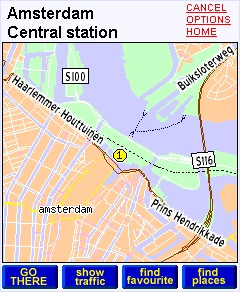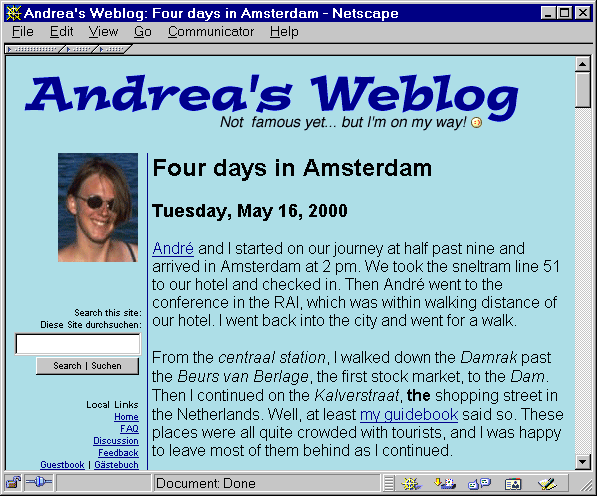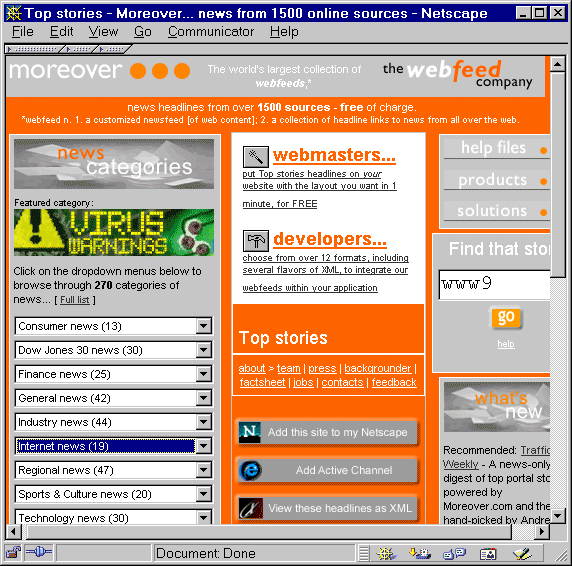Web Focus: Reflections On WWW9
The Ninth International World Wide Web conference (WWW9) was held at the RAI Congress Centre in Amsterdam. The main part of the conference took place from Tuesday 16th till Thursday 18th May. A day of tutorial and workshops was held on Monday 15th May with the Developer's Day on Friday 19th May. About 1,400 delegates attended the conference. It was pleasing to note the large numbers of delegates from the UK - about 100 in total, with about 50% from the Higher Education community (and about 9 people from Southampton University and another 9 from Bristol University).
The general consensus seemed to be that the conference was a great success - although that may be influenced not only by the quality of the technical papers, keynote presentations and panel sessions but also by the attractions of Amsterdam!
The conference Web site is still available [1] although this year it appears that the papers are not available.
Conference Highlights
The main theme of the conference was The Mobile Web. Several Keynote speakers addressed this topic including Egbert-Jan Sol of Ericsson, whose talk on "Making the Internet Mobile for Everybody" predicted a bright future for users of mobile devices, citing statistics such as 100 million PCs versus 275 million mobile phones sold in 1999 and predicting that in the near future all new mobiles would be able to access the Internet. In Europe we have a lead over the US thanks to use of a single standard (GSM) as opposed to the several standards (TDMA, CDMA, GCM, etc.) used in the US.
Charles Davies Psion described the role of Wireless Information Devices. Charles predicted a growth in a variety of devices including PDAs, mobile phones and PCs. He felt that Bluetooth [2] would have an important role in providing temporary networking between a variety of devices. Charles was clearly a fan of gadgetry. Not only did he carry several PDAs and mobile phones, he also gave a demonstration of a simulation of a third generation mobile phone device. An screen dump (taken from the TomTom Web site [3]) which illustrates the potential for WAP phones is shown below.

Figure 1: Example of a Mobile Phone Interface
As might be expected more discussion occurred in the panel session on "Towards a WAP-Wide Web?". Phone.com's Bruce Martin had to respond to criticism that a proprietary approach had been taken initially. Bruce tried to deflect the criticism and argued that the WAP Forum [4] and W3C were now working closely together in the development of standards such as the WML family of protocols [5].
Although we can expect to see many arguments about the benefits of mobile Internet, access costs, performance, security, deployment costs, standards battles, etc. [6] [7] it is clearly an area which cannot be ignored.
XHTML + XSLT = :-)
Unlike 1997 (when XML was the technological highlight of the WWW conference) and 1998 (with RDF) this year's technological highlights featured a combination of the old and the new. XHTML [8] is simply HTML 4.0 expressed as an XML application. HTML authors should find mastering XHTML to be a simple task. A simple comparison is given in the following table.
| Rule | XHTML | HTML |
| Element names must be in lower case | <p> | <P> |
| Elements must be closed | <li>list item</li> | <li>list item |
| Attribute values must be quoted | <table border="1"> | <table border=1> |
| Empty elements must be terminated | <img src="logo.gif alt="logo" /> | <img src="logo.gif alt="logo"> |
It was expected that expressing documents in XHTML as opposed to HTML would provide benefits such as ability to use XML tools and use of new XML-related protocols such as XLink and XPointer [9]. The development of XLink and XPointer protocols has proved to be more difficult than originally expected. However XSLT has recently been developed and may provide the motivation for organisations to deploy XHTML instead of HTML.
XSLT (Extensible Style Language Transformation) [10] enables XML documents to be transformed into other types of documents. Used in conjunction with XSLT transformation engines resources can be transformed from, say, XHTML to other XML applications. XSLT has been promoted as the key to widespread deployment of WAP devices, by enabling XHTML documents to be converted to WML format without manually intervention. As well as transforming elements (e.g. <p> to, say, <card>) XSLT can also filter XML documents: for example, only the <h1> and <h2> headings could be converted.
XSLT shows potential in other areas: for example, it could be used to convert structured metadata into alternate forms. Alison Cawsey, Heriot-Watt University presented a paper at the WWW9 conference which gave an example of how XSLT can be used to present tailored resource descriptions based on Dublin Core metadata [11].
Poster Session
I was pleased this year to have two posters accepted for presentation at the conference. "Approaches To Indexing In The UK Higher Education Community" [12] reviewed the indexing tools used to index institutional Web services in the UK HE community (as previously described in Ariadne) [13], described the limitations of a Web-centric approach, and concluded by mentioned developments within eLib and the DNER.
"A Lightweight Approach To Support Of Resource Discovery Standards" [14] described how Dublin Core metadata is being used to provide enhanced search facilities in the Exploit Interactive Web magazine.
Unfortunately due to my involvement with the two poster displays it was difficult for me to view many of the other displays. However it was pleasing to note the number of contributions from the UK HE community, including:
- "People Power and the Semantic Web: Building Quality Controlled Portals" [15] by Martin Belcher and Emma Place, University of Bristol
- "Online Learning - Evaluating the Learning Experience" [16] by Ray Thompson and John Steel, Sheffield Hallam University
- "Towards a Self-Organising Learning Environment" [17] by Jon Dron, Chris Boyne, Phil Silver and Richard Mitchell, University of Brighton
- "Search Interfaces for Handheld Mobile Devices" [18] by George Buchanan and Matt Jones, Middlesex University
- "A Usability Tool for Web Evaluation Applied to a Digital Library Design" [19] by Yin Leng Thng, Norliza and Harold Thimbleby, Middlesex University
- "An Ad Hoc Linkbase Generation Scenario" [20] by David De Roure, Danius Michaelides and Mark Thompson, University of Southampton
- "Web Scholars" by Simon Kampa and Les Carr, University of Southampton
- "Is The WWW Killing Hypermedia" by Les Carr, Wendy Hall and Timothy Miles-Board, University of Southampton
- "Where Do I Go From Here: A Multiagent System to Support Collaborative Web Browsing" by Samhaa El-Beltagy, David De Roure and Wendy Hall, University of Southampton
Developers Day
In the morning of the final day I attended the Semantic Web track. This consisted of a mixture of theoretic presentations (such as Dan Connolly's talk about using Larch to provide formal proofs of W3C specs) and more pragmatic presentations on applications which make use of RDF.
Jose Kahan of W3C gave a talk about a W3C collaborative web annotation project [21]. It uses the Amaya browser/editor which can point to annotation servers. Users can use Amaya to annotate pages. The annotations (author, type of annotation, such as flame, date info, etc.) is stored on the annotation server as RDF. When another user browses the page, any annotations for the page which are held by annotation servers which have been selected will be flagged (the DOM is used to dynamically update the document after it has been downloaded from the web server).
Because the annotation is in RDF, the Semantic Web can be used to retrieve related resources. The example given showed how choosing Tim Berners-Lee as author enables a photo of Tim to be retrieved.
Dave Beckett (formerly of the UK Mirror Service and now working at ILRT, University of Bristol) gave an excellent talk on "Getting There From Here - Deploying RDF in a Large Scale Mirror Service" [22]. RDF is used in the descriptions of the mirrored files and also descriptions of the mirrors themselves. Dave has defined a couple of RDF schemas - it would be interesting to know if these will be standardised within the mirroring community. Dave's talk was well-presented and gave a good example of a large service (about 200 mirrors, 440 Gb, 2-3 M files) using RDF in a production environment.
Lunch was billed as "Lunch with Tim Berners-Lee". If Tim ever chooses to leave W3C he would walk into a job as a daytime TV host. Tim walked around the audience, microphone in hand, making the occasional comment about the Web ("The Web is developing nicely, everyone is moving towards XML, ... Or the Web is broken, getting too difficult. What do *you* think?") and getting response from the audience.
One person pointed out that a number of computer gurus (such as Steve Job with Apple II) had produced something wonderful initially, but then failed with a followup (Apple III). Would the Semantic Web be Tim's downfall? No conclusion was reached, although it was interesting to note that W3C's involvement in developing the Semantic Web will be funded by a DARPA grant.
After lunch I attended the Web Publishing Tools and Techniques Track.
The first talk was by Michael Lars von Olleschik, who talked about the InfoSite system for managing content [23]. This was developed using ColdFusion (a Java version is to come) and provides a web-interface for managing websites.
David Winer then spoke about "Weblogs in Manila". Manila is a "low-cost web-based content management systems aimed at the mass market [24]. It will cost $899 per (NT) server - unlimited number of sites." It seems an interesting applications - especially as David Winer is active in web protocol developments such as SOAP, WML-RPC and RSS.
Manila can be used to create Weblogs. Weblogs are described as "often-updated sites that point to articles elsewhere on the web, often with comments, and to on-site articles." [25].
It was interesting to observer that several participants at the conference used Weblogs to write their trip reports, as illustrated below.

Figure 2: Andrea's Weblog
As well as Andrea's Weblog [26] David Singer [27] and Dave Winer [28] have also written Weblogs about the conference.
After coffee the theme of the track was XML Publishing Applications. Simon Bosse of Koninklijke Bibliotheek (National Library of the Netherlands) spoke about use of XML within his library [29]. He described how a centralised approach to providing access to the wide range of services held at the Library is being taken. In response to my comment on the distributed approach which is being taken in the UK., Simon responded that Z39.50 was difficult to deploy, although he acknowledged that a distributed approach had many advantages.
David Galbraith of MoreOver [30] spoke on "Using XML for News Aggregation and Delivery". This was a very interesting talk which describes the behind-the-scenes working of MoreOver, A UK-based company which describes itself as "The world's largest collection of webfeeds". The MoreOver home page is shown in Figure 3.

Figure 3: Moreover
Although the MoreOver service itself is interesting (as an aside, search for "WWW9" to get new storied about the conference) developers will be more interested to hear that the site uses XML, RDF and RSS to manage newsfeeds.
David mentioned that RSS (Rich Site Summary) [31] was being extended (DTD is limited to 15 items, but people are breaking this). I asked about the ownership of RSS and responsibilities for standardisation. RSS was originally developed by Netscape, but, following the AOL takeover of Netscape the ownership and responsibilities for future development of RSS are unclear. However it was clear from the interest expressed that people are keen on RSS being developed further.
WWW10 Conference
Next year's conference (WWW10) will be held in Hong Kong [32].
References
- 9th International World Wide Web Conference
http://www.www9.org/ - The Official Bluetooth SIG Website
http://www.bluetooth.com/ - TomTom
http://www.tomtom.com/ - WAP Forum
http://www.wapforum.org/ - WAP Forum Specifications
http://www.wapforum.org/what/technical.htm - Wireless Web Fight Gets Catty, David Sims, Wired
http://www.wired.com/news/technology/0,1282,36051,00.html - WAP: Dead or Alive?
http://MobylPinas.editthispage.com/stories/storyReader$26 - XHTML 1.0: The Extensible HyperText Markup Language, W3C Recommendation, 26 January 2000
http://www.w3.org/TR/xhtml1/ - What Are... XLink and XPointer?, Ariadne issue 16
http://www.ariadne.ac.uk/issue16/what-is/ - XSL Transformations (XSLT) Version 1.0, W3C, 16 November 1999
http://www.w3.org/TR/xslt - Presenting tailored resource descriptions: Will XSLT do the job?, Alison Cawsey, 9th International Conference on the World Wide Web, May 2000
http://www.cee.hw.ac.uk/~alison/www9/paper.html - Approaches To Indexing In The UK Higher Education Community, Brian Kelly, Poster Proceedings, 9th International Conference on the World Wide Web, May 2000
http://www.ukoln.ac.uk/web-focus/papers/www9/indexing/ - WebWatch: UK University Search Engines, Brian Kelly, Ariadne, issue 21
http://www.ariadne.ac.uk/issue21/webwatch/ - A Lightweight Approach To Support Of Resource Discovery Standards, Brian Kelly, Poster Proceedings, 9th International Conference on the World Wide Web, May 2000
http://www.ukoln.ac.uk/web-focus/papers/www9/resource-discovery/ - People Power and the Semantic Web: Building Quality Controlled Portals, Martin Belcher and Emma Place, University of Bristol
http://www.desire.org/w9-poster.html - Online Learning - Evaluating the Learning Experience, Ray Thompson and John Steel, Sheffield Hallam University
http://service.shu.ac.uk/topclass/files/www9poster.htm - Towards a self-organising learning environment, Jon Dron, Richard Mitchell, Chris Boyne, Phil Siviter, University of Brighton
http://www.it.bton.ac.uk/staff/jd29/www9poster.html - Search Interfaces for Handheld Mobile Devices, George Buchanan & Matt Jones, University of Middlesex
http://www.cs.mdx.ac.uk/staffpages/mattjones/web9poster.html - A usability tool for web evaluation applied to digital library design, Yin Leng Theng, Norliza Mohd-Nasir, Harold Thimbleby, Middlesex University
http://www.cs.mdx.ac.uk/staffpages/yinleng/www9-tool.html - An Ad Hoc Linkbase Generation Scenario, David De Roure, Danius Michaelides and Mark Thompson, University of Southampton
http://www.bib.ecs.soton.ac.uk/records/3423 - The W3C Collaborative Web Annotation Project ... or how to have fun while building an RDF infrastructure, W3C Staff
http://www.w3.org/2000/Talks/www9-annotations/ - Getting There From Here - Deploying RDF in a Large Scale Mirror Service, Dave Beckett
http://www.ilrt.bristol.ac.uk/people/cmdjb/talks/www9/ - Infosite, Sitepark
http://www.sitepark.com/ - What Is Manila?
http://manila.userland.com/ - What Are Weblogs?
http://www.weblogs.com/about - Andrea's Weblog: Four days in Amsterdam
http://andrea.editthispage.com/amsterdam/english - Defenestration Corner, David Singer
http://dss.editthispage.com/AmsterdamDiary - Scripting News, Dave Winer
http://scriptingnews.userland.com/backIssues/2000/05/15 - XML at the Koninklijke Bibliotheek, Simon Bosse
http://www.kb.nl/persons/simon/kbc-en/ - MoreOver
http://www.moreover.com/ - RSS resources, XMLTree
http://www.xmltree.com/rss/ - Tenth International World Wide Web Conference
http://www.www10.org/
Author Details
 Brian Kelly
Brian Kelly
UK Web Focus
UKOLN
University of Bath
Bath
BA2 7AY
Email: b.kelly@ukoln.ac.uk
Brian Kelly is UK Web Focus. He works for UKOLN, which is based at the University of Bath
